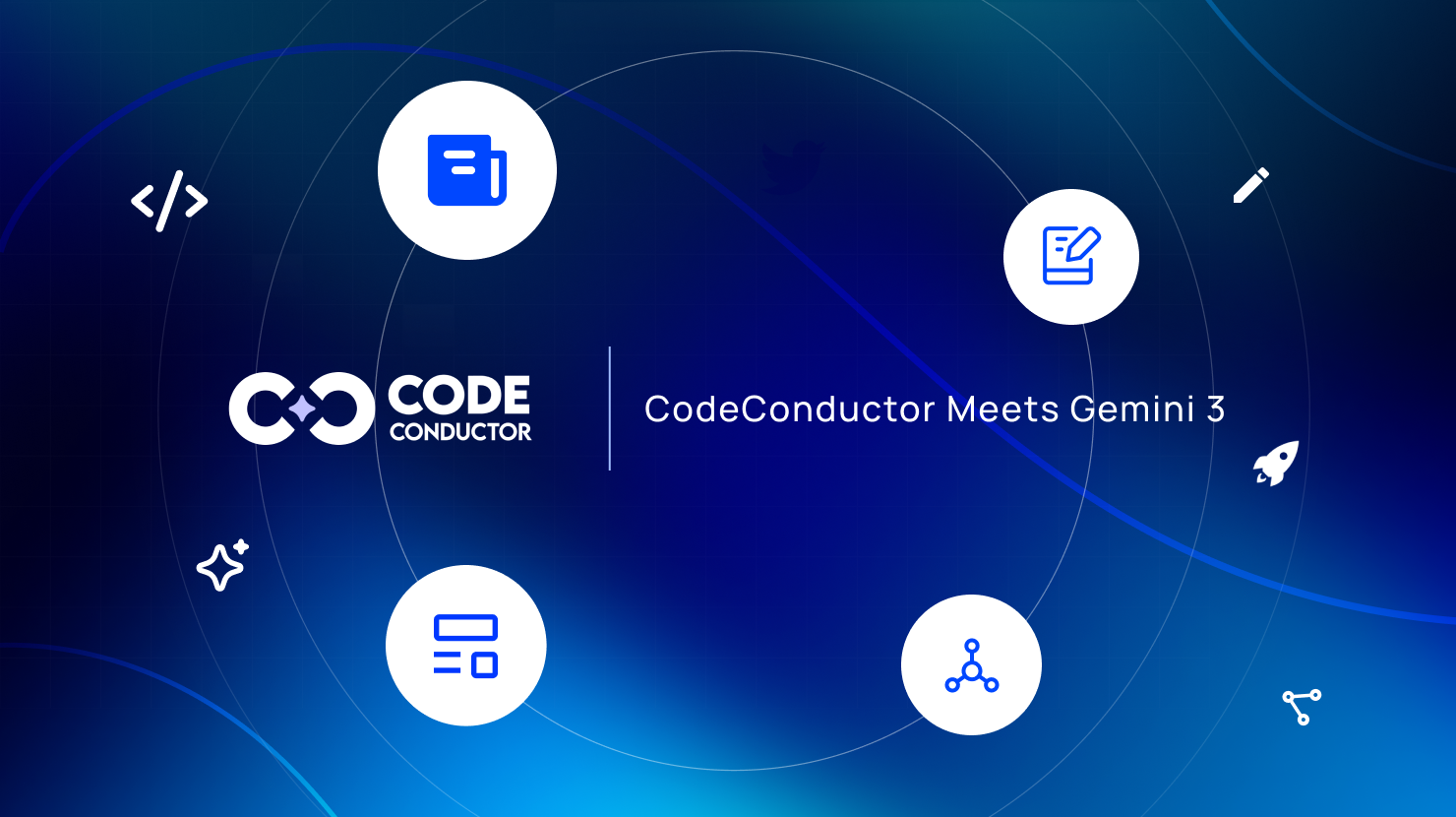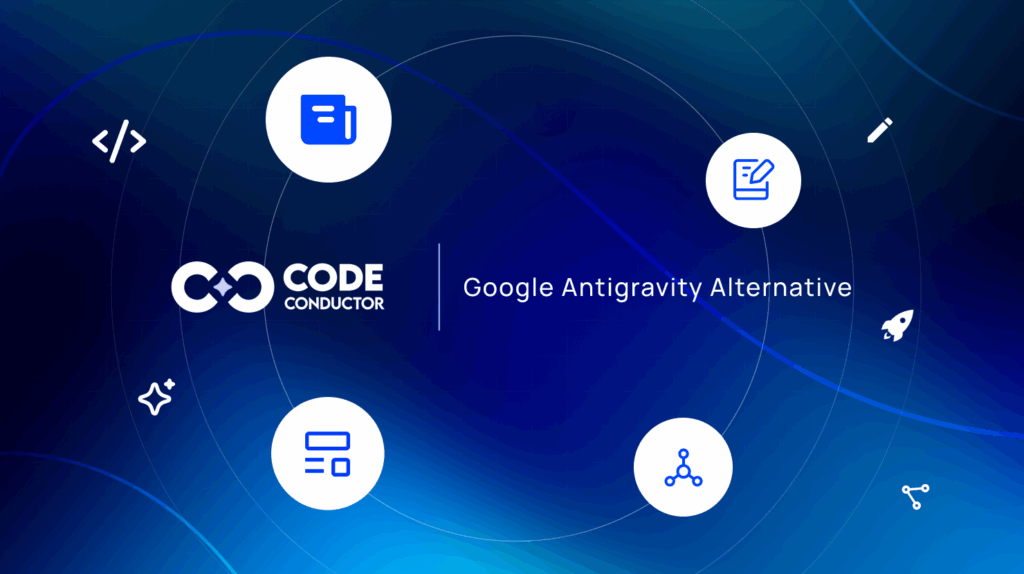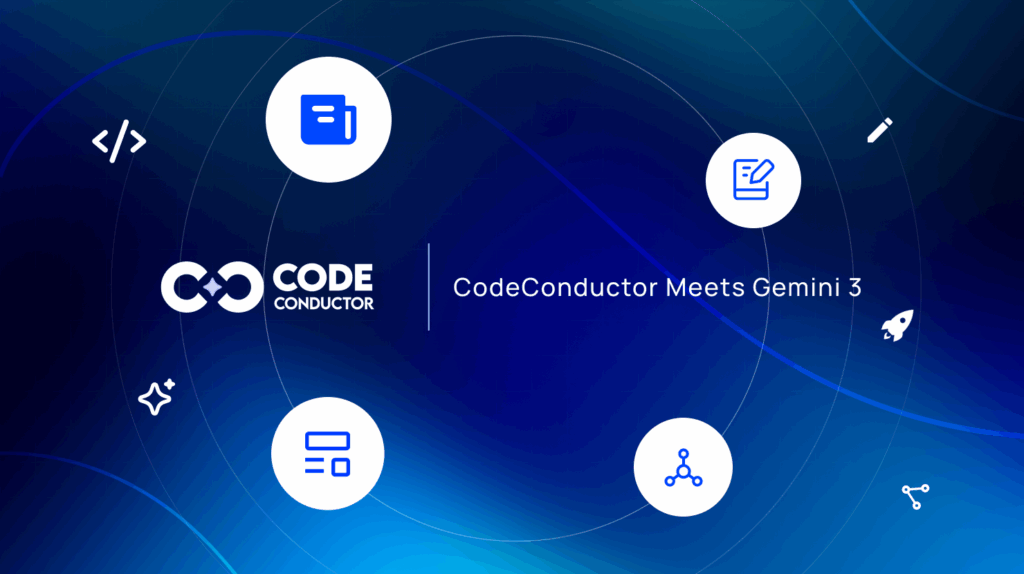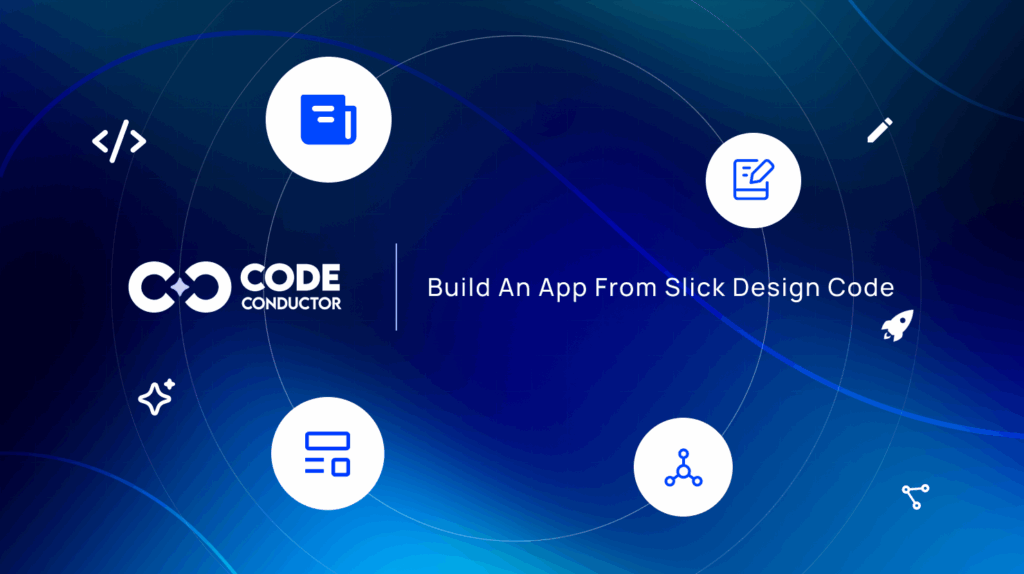November 19, 2025 — Yesterday changed everything. With Google’s release of Gemini 3, the goalposts for AI development didn’t just move; they vanished.
For the last two years, we’ve all been playing the “Generative Game”—prompting AI to spit out React components, Python scripts, and SQL queries. It was fast, but it was often fragile. You got code, but you didn’t always get architecture.
Today, CodeConductor is upgrading its brain.
We are proud to announce that CodeConductor is now powered by Gemini 3, specifically leveraging its breakthrough “Deep Think” and “Vibe Coding” capabilities. This isn’t just a speed update. It marks a fundamental shift in how our platform builds software for you: we are moving from Generative AI (predicting the next line of code) to Reasoning AI (simulating the entire system before writing a single character).
When you build with CodeConductor today, you aren’t just getting a faster coder. You are getting a senior software architect who thinks, plans, and problem-solves in the background—long before it hits “deploy.”
In This Post
What Is Gemini 3?
Gemini 3 is Google’s next major leap beyond 2.5 Pro, designed to turn abstract ideas into fully realized software with far less instruction. It excels at zero-shot reasoning, understands layered prompts, and produces richer, more interactive interfaces without the need for over-engineering your request.
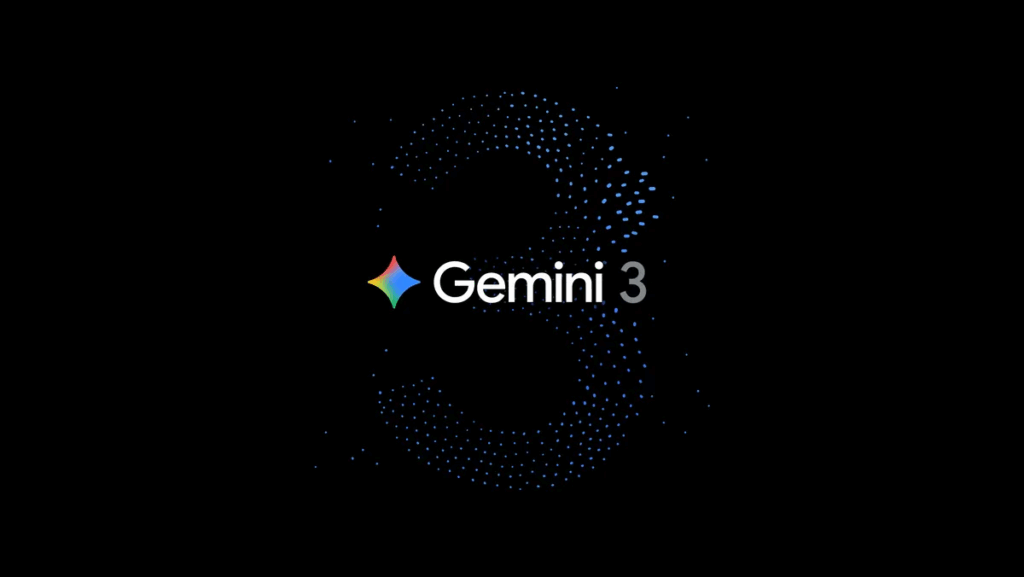
It’s also Google’s strongest vibe-coding and agentic-coding model to date. In independent evaluations, Gemini 3 sets new benchmarks:
- 1487 Elo on the WebDev Arena leaderboard
- 54.2% on Terminal-Bench 2.0 for autonomous tool use
- 76.2% on SWE-bench Verified, showing huge gains over 2.5 Pro in real-world coding tasks
Developers can use Gemini 3 across Google AI Studio, Vertex AI, the Gemini CLI, and the new agentic development environment, Google Antigravity. It’s also already integrated into major third-party platforms such as Cursor, GitHub, JetBrains, Manus, and Replit — making it widely accessible from day one.
The “Deep Think” Architecture Builder
Beyond Syntax: How We Engineered the “The Pause”
In the world of AI coding, speed has always been the primary metric. How fast can you generate a landing page? How quickly can you scaffold an API? But speed without direction is just a fast way to build technical debt.
With the integration of Gemini 3’s “Deep Think” capabilities, CodeConductor introduces a critical new step in the generation process: The Strategic Pause.
When you give CodeConductor a complex instruction—say, “Build a multi-tenant SaaS platform for logistics management”—it no longer rushes to write index.js. Instead, our background agents trigger Gemini 3’s reasoning mode to simulate the application’s lifecycle before a single line of code is written.
What’s Happening in the Background?
While you see a “Thinking…” status, CodeConductor is performing a high-speed architectural review:
- Dependency Simulation: We don’t just pick libraries; we verify compatibility. Gemini 3 simulates the interaction between your chosen database (e.g., PostgreSQL) and your frontend framework to predict potential latency bottlenecks or ORM conflicts.
- Security Pre-Flight: Before writing the authentication flow, CodeConductor “attacks” its own mental model. It looks for logic gaps where user data might leak between tenants, patching these vulnerabilities at the architectural level rather than the code level.
- Scalability Logic: Instead of writing the simplest code that works, Gemini 3 evaluates if the proposed database schema will hold up under 10,000 users vs. 10 users.
The Result: Architecture, Not Just Code
The difference is palpable. “Old” generative AI builds software like a junior developer: it solves the immediate error message in front of it.
CodeConductor with Gemini 3 builds like a Senior Architect. It anticipates the error you would have hit three months from now and engineers around it today. You aren’t just getting code that runs; you’re getting a codebase that is ready to scale.
The End of Prompt Engineering: Enter “Vibe Coding”
Don’t Describe the CSS. Describe the Feeling.
For years, the barrier to entry for building great software wasn’t just coding knowledge; it was “Prompt Engineering.” To get a great UI, you had to be a technical linguist. You had to explicitly ask for “High contrast, Brutalist design style, 2px borders, #000000 hex codes, and monospace typography.”
If you didn’t know the vocabulary, you didn’t get the result.
With Gemini 3’s “Vibe Coding” engine running in the background of CodeConductor, we are dismantling that barrier. We have moved from an era of instruction to an era of intention.
Translating “Vibes” into Design Systems
How does CodeConductor leverage this? We’ve tuned Gemini 3 to act as a Semantic Translator between your abstract ideas and concrete design tokens.
You can now tell CodeConductor:
“Make the dashboard feel urgent and punchy, like a Wall Street trading floor.”
In the background, Gemini 3 doesn’t just look for keywords; it parses the emotional context of that request and maps it to technical execution:
- “Urgent” translates to high-visibility alert components, red/green status indicators, and dense data grids.
- “Punchy” triggers sharper border radii, high-contrast typography, and micro-interactions that respond instantly to clicks.
- “Trading Floor” informs the layout density, prioritizing information volume over whitespace.
From Napkin Sketch to Production Ready
This capability extends beyond text. Because Gemini 3 is natively multimodal, CodeConductor can now ingest the “vibe” from visual inputs.
Upload a screenshot of a vintage sci-fi poster or a photo of a clean, minimalist coffee shop.
CodeConductor analyzes the color palette, the spatial relationships, and the mood of the image, and instantly generates a UI theme that matches that essence.
You no longer need to know the difference between flex-row and grid-cols. You just need to know what you want your users to feel. CodeConductor handles the rest.
True Agentic Autonomy: The Rise of the Self-Healing App
When the Code Breaks, The Agent Wakes Up
The dirty secret of the first generation of AI coding tools was their fragility. They could write code, but they couldn’t fix it. If an AI-generated script hit a runtime error, the AI would often hallucinate a fix or simply apologize. The human developer was left to pick up the pieces.
CodeConductor changes this dynamic by leveraging Gemini 3’s advanced agentic capabilities. We don’t just generate code; we spawn autonomous agents that monitor their own output.
We call this “The Self-Healing Loop.”
How It Works: Recursion with Reason
Imagine you ask CodeConductor to integrate a specific payment gateway API. Halfway through the build, the agent encounters a 401 Unauthorized or a generic Internal Server Error because the API documentation has changed.
In the old world, the process stops. In the CodeConductor world, the Gemini 3 agent activates:
- Diagnosis (Reading the Logs): The agent captures the error stack trace. Because of Gemini 3’s massive context window, it doesn’t just see the error; it reads the error in the context of the entire application logic.
- Tool Use (Verification): Instead of guessing, the agent autonomously launches a web browser to check the latest documentation for that specific API. It identifies that a parameter name has changed in the latest version.
- Refactoring (The Fix): The agent rewrites the integration code to match the new documentation.
- Verification (The Test): It re-runs the build internally to ensure the error is gone before presenting the solution to you.
From “Human-in-the-Loop” to “Human-at-the-Helm”
This is the definition of Agentic AI. CodeConductor doesn’t ask you to debug its work. It uses Gemini 3’s reasoning engine to iterate on its own mistakes until the code compiles and executes correctly.
The result is a dramatic reduction in “Configuration Fatigue.” You aren’t debugging imports or chasing syntax errors. You are directing a team of autonomous agents that clean up their own mess, ensuring that when you click “Deploy,” the application actually works.
Conclusion: The Future Isn’t Written, It’s Reasoned
One Brain, One Million Tokens, Infinite Possibilities
As we integrate Gemini 3 into the core of CodeConductor, we are excited about the features we’ve discussed—the reasoning, the vibe coding, and the self-healing agents. But there is one final piece of the puzzle that makes this combination truly revolutionary: Context.
Gemini 3’s massive token context window allows CodeConductor to hold your entire digital reality in its working memory simultaneously. It doesn’t just look at the file you are currently editing. It “sees” your legacy database schema, your brand guidelines PDF, your API documentation, and your user feedback logs—all at once.
This eliminates the disjointed “hallucinations” of the past. CodeConductor understands the whole picture, ensuring that changes to your frontend logic respect the constraints of your backend architecture.
Stop Coding. Start Conducting.
The release of Gemini 3 is a signal that the era of “Generative AI” is maturing into the era of “Reasoning AI.”
At CodeConductor, we believe that you shouldn’t have to be a prompt engineer to be a software engineer. You shouldn’t have to debug AI-generated code. You should be the conductor of a symphony of agents that think, plan, and execute on your behalf.
The tools of yesterday guessed what you wanted. CodeConductor with Gemini 3 understands what you need.
Experience the Gemini 3 Update on CodeConductor – Start Building for Free
FAQs
Has Gemini 3 been released?
Yes. Google officially released Gemini 3 yesterday, November 18, 2025.[1]
It is currently rolling out globally to developers and enterprise users. At CodeConductor, we gained early access to the API release candidate, which is why we are able to offer these new “Reasoning” features to our users starting today.
What’s new with Gemini 3?
Gemini 3 introduces three massive shifts from the Gemini 2.5 era:
- “Deep Think” Mode: The model can now pause to simulate and “reason” through complex architectural problems before generating a response, drastically reducing logic errors.
- Vibe Coding: It understands abstract emotional and aesthetic instructions (e.g., “Make it feel like a cyberpunk terminal”) without needing detailed CSS specifications.
- Agentic Reliability: It has a significantly higher success rate in using external tools (browsers, APIs) without getting stuck in loops, making it the first true “Self-Healing” model.
How do I access Gemini 3?
There are two ways to use it:
- The Hard Way (For Developers): You can access the raw model via Google AI Studio or Vertex AI if you have an enterprise Google Cloud account. You will need to manage your own API keys, rate limits, and context window optimizations.
- The Easy Way (For Builders): You can access Gemini 3 right now inside CodeConductor. We have already handled the API integration, context caching, and parameter tuning. Just switch your project settings to “Model: Gemini 3 (Reasoning)” and start building immediately.

Founder CodeConductor

